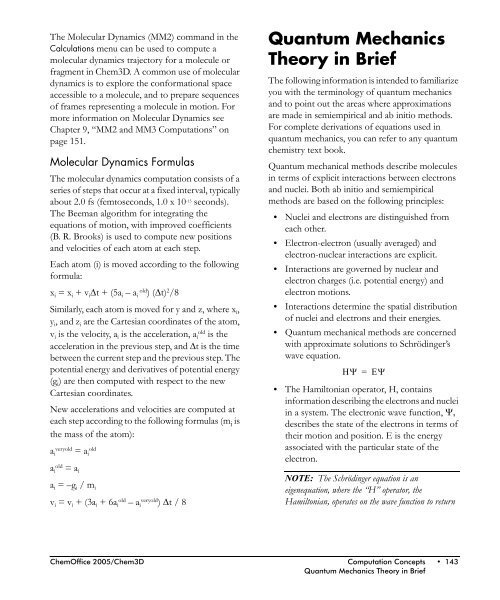Chem3D Users Manual - CambridgeSoft
Chem3D Users Manual - CambridgeSoft
Chem3D Users Manual - CambridgeSoft
You also want an ePaper? Increase the reach of your titles
YUMPU automatically turns print PDFs into web optimized ePapers that Google loves.
The Molecular Dynamics (MM2) command in the<br />
Calculations menu can be used to compute a<br />
molecular dynamics trajectory for a molecule or<br />
fragment in <strong>Chem3D</strong>. A common use of molecular<br />
dynamics is to explore the conformational space<br />
accessible to a molecule, and to prepare sequences<br />
of frames representing a molecule in motion. For<br />
more information on Molecular Dynamics see<br />
Chapter 9, “MM2 and MM3 Computations” on<br />
page 151.<br />
Molecular Dynamics Formulas<br />
The molecular dynamics computation consists of a<br />
series of steps that occur at a fixed interval, typically<br />
about 2.0 fs (femtoseconds, 1.0 x 10 -15 seconds).<br />
The Beeman algorithm for integrating the<br />
equations of motion, with improved coefficients<br />
(B. R. Brooks) is used to compute new positions<br />
and velocities of each atom at each step.<br />
Each atom (i) is moved according to the following<br />
formula:<br />
x i = x i + v i ∆t + (5a i – a<br />
old<br />
i ) (∆t) 2 /8<br />
Similarly, each atom is moved for y and z, where x i ,<br />
y i , and z i are the Cartesian coordinates of the atom,<br />
v i is the velocity, a i is the acceleration, a<br />
old<br />
i is the<br />
acceleration in the previous step, and ∆t is the time<br />
between the current step and the previous step. The<br />
potential energy and derivatives of potential energy<br />
(g i ) are then computed with respect to the new<br />
Cartesian coordinates.<br />
New accelerations and velocities are computed at<br />
each step according to the following formulas (m i is<br />
the mass of the atom):<br />
veryold old<br />
a i = a i<br />
a i<br />
old<br />
= a i<br />
a i = –g i / m i<br />
v i = v i + (3a i + 6a i<br />
old<br />
– a i<br />
veryold<br />
) ∆t / 8<br />
Quantum Mechanics<br />
Theory in Brief<br />
The following information is intended to familiarize<br />
you with the terminology of quantum mechanics<br />
and to point out the areas where approximations<br />
are made in semiempirical and ab initio methods.<br />
For complete derivations of equations used in<br />
quantum mechanics, you can refer to any quantum<br />
chemistry text book.<br />
Quantum mechanical methods describe molecules<br />
in terms of explicit interactions between electrons<br />
and nuclei. Both ab initio and semiempirical<br />
methods are based on the following principles:<br />
• Nuclei and electrons are distinguished from<br />
each other.<br />
• Electron-electron (usually averaged) and<br />
electron-nuclear interactions are explicit.<br />
• Interactions are governed by nuclear and<br />
electron charges (i.e. potential energy) and<br />
electron motions.<br />
• Interactions determine the spatial distribution<br />
of nuclei and electrons and their energies.<br />
• Quantum mechanical methods are concerned<br />
with approximate solutions to Schrödinger’s<br />
wave equation.<br />
HΨ = EΨ<br />
• The Hamiltonian operator, H, contains<br />
information describing the electrons and nuclei<br />
in a system. The electronic wave function, Ψ,<br />
describes the state of the electrons in terms of<br />
their motion and position. E is the energy<br />
associated with the particular state of the<br />
electron.<br />
NOTE: The Schrödinger equation is an<br />
eigenequation, where the “H” operator, the<br />
Hamiltonian, operates on the wave function to return<br />
ChemOffice 2005/<strong>Chem3D</strong> Computation Concepts • 143<br />
Quantum Mechanics Theory in Brief











